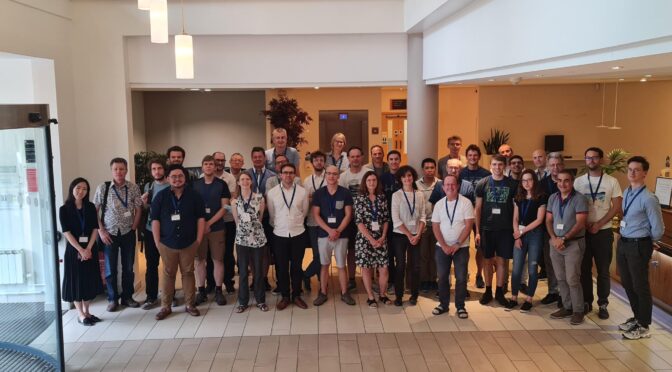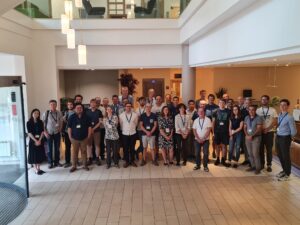CECAM/Psi-K Flagship Workshop “Light-matter interaction and ultrafast nonequilibrium dynamics in plasmonic materials”
July 18, 2022 – July 21, 2022, University of Warwick, UK
Description of Event
The Psi-K & CECAM sponsored meeting “Light-matter interaction and ultrafast nonequilibrium dynamics in plasmonic materials” was held from 18th to 21st of July 2022 at the University of Warwick. It featured 28 talks, 4 discussion sessions, and 10 posters. It was attended by 42 in-person attendees from 12 different countries and broadcast as a webinar with between 3 and 17 virtual attendees at any time.
A full theoretical description of light-matter interaction and plasmon-induced ultrafast non-equilibrium dynamics is a formidable challenge that demands an intrinsically multidisciplinary and multiscale approach. A variety of different approaches based on time-dependent Density Functional Theory, many-body perturbation theory, molecular dynamics, Mie theory, continuum electrodynamics, and combinations thereof have emerged in recent years to address many of the open questions in plasmonics. Further improvements in theoretical descriptions are crucial to optimize SPP generation and amplification in materials, to tailor losses and plasmonic lifetimes, as well as to integrate plasmonic effects into semiconductor technology to create new quantum materials. Due to the diverse aspects of this problem, a coherent research community around theoretical plasmonics is only slowly emerging.
The aim of this workshop was to assess the state of computational methods in this field, to identify major challenges, as well as to provide engagement between disparate communities to create space for cross-community collaboration.
Report
The workshop brought attention to the diversity of materials, physical phenomena, and theoretical and experimental methods that are relevant for plasmonics and for its application to the field of photocatalysis. Several presenters emphasised the opportunities to discover new ultrafast physics when strong plasmonic resonances at interfaces are triggered such as optical nonlinearity and plasmon-induced photoemission. An emerging research stream is the use of polarised light and chiral structures to engineer unique materials properties. Exciting new experimental techniques are emerging and their capability to harness strong near-field effects was among the discussion topics of this workshop. These include tip-enhanced Raman spectroscopy, EELS-STEM, as well as photon-induced near-field electron microscopy. Theoretical investigations need to be able to predict the non-linear response that these measurements observe.
The common understanding of plasmon-assisted chemical reactions typically relies on the energy exchange among hot-electrons (photo or plasmonically excited on plasmonic nanoparticles) and molecular adsorbates. An important issue that still remains to be addressed in this field consists in revealing the influence of more complex many-body excitations and quasiparticles for chemical reactions in plasmonic compounds. The question of whether plasmons directly couple to phonons or only act a source of hot electrons still remains to be addressed.
A clear need was identified for electronic structure techniques that are scalable and able to address strong correlation effects in materials as well as strong light-matter interaction. Currently few viable methods exist to study electronic excited states at molecule-metal interfaces, which also directly limits the use of nonadiabatic molecular dynamics techniques and real-time time-dependent DFT to study how electronic excitation drives dynamics at the interface. Promising methods were identified as exchange-correlation functionals that correctly predict the level alignment at the interface and many body perturbation theory methods that capture frequency and lifetime of 1-particle and 2-particle excitations. The special properties of plasmonic and other collective resonances in unusual plasmonic materials such as Magnesium or two-dimensional materials was also discussed. In the latter case, it was raised that this likely requires electronic structure methods that can address strong correlation effects as they occur in the presence of flat bands (e.g. the constrained RPA method).
It was discussed that observed dynamical mechanisms likely differ between pulsed lasers and continuous white light illumination. It remains unclear if dynamics at the interface will be dominated by thermalised electrons at elevated temperatures or truly non-equilibrium electron distributions created by light excitation. Collective plasmonic excitations mainly decay into electronic excitations at the Fermi level. The origin of this effect is currently being investigated, but a full theoretical understanding is currently lacking. However, real-time TD-DFT simulations of plasmon decay also show evidence of this effect. This is an example where two different communities found corroborating evidence of the same effect, which we established as part of this conference.
Organizers
Reinhard Maurer (University of Warwick)
Oscar A. Douglas-Gallardo (University of Warwick)
Fabio Caruso (University of Kiel)
Dino Novko (Institute of Physics, Zagreb)
Bärbel Rethfeld (Technical University of Kaiserslautern)
Detailed Program
The program can be found here: https://www.cecam.org/workshop-details/1164#program_tab
The list of talk titles and abstracts can be found here: https://members.cecam.org/storage/workshop_files/PW_abstracts-1658142161.pdf
Participants
The complete list of participants and invited speakers can be found here: https://www.cecam.org/workshop-details/1164#participant_tab
Feedback from Participants
Many attendees positively commented on the interdisciplinary nature of this workshop, and on the diversity in the background of the attendees. Many attendees were exposed to new topics, methods, and approaches for tackling problems pertaining to the field of ultrafast plasmonics. A clear outcome of the workshop was the need to enable more space for such cross-community gatherings in a field that is defined by an unusually broad spread of classical and quantum methods that originate from condensed matter physics, chemistry, and optics. During the final discussion session, participants were very vocal about wanting to establish a series format of this workshop running every 2-3 years that reflects the fast progress of different communities on ultrafast plasmonics. We believe that a series of CECAM workshops would be the best way to serve the need for different communities to exchange ideas on a regular basis.
Conclusions and prospects
Mechanistic understanding of all relevant processes, including the plasmonic excitation, ultrafast electron dynamics and the electron-driven molecular dynamics is crucial to design optimal plasmonic devices and catalysts. Theoretical plasmonics and dynamics simulations that utilize a broad spectrum of classical and quantum mechanical methods are vital to achieve such an understanding.
All attendees agreed that meetings with space for discussions between participants from different theoretical communities, in particular from plasmonics, electronic structure theory, quantum chemistry, and surface science together should continue. As this field is intrinsically multidisciplinary and multi-method focussed, regular exchanges across communities are crucial. Many attendees left the meeting with new research ideas, having met new potential collaborators.
We would like to thank our sponsors: Psi-k, CECAM-UK node Daresbury, and UKRI.


